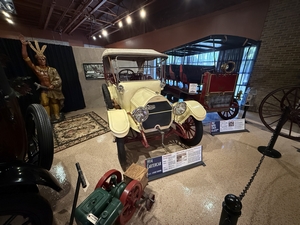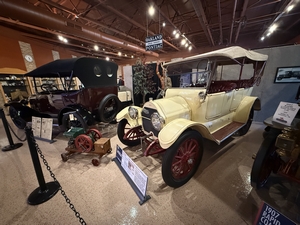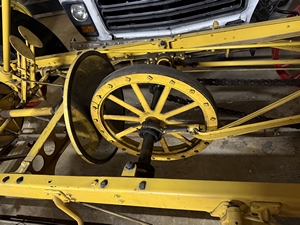

















|
|---|
|
Cartercar Category: Vehicle Marque Wikipedia: Cartercar Description: A manufacturer of vehicles founded by and named for Byron J. Carter. They were based in Pontiac, Michigan and began manufacturing automobiles with a “friction drive transmission,” an early predecessor of the continuously variable transmission, in 1907. They were bought by General Motors in 1909 and closed in 1915. Page Sections: History · Photographs · Article Index |
The following section is an excerpt from Wikipedia's Cartercar page on 2 November 2024, text available via the Creative Commons Attribution-ShareAlike 3.0 Unported License.
After leaving the Jackson Automobile Company due to a disagreement with his business partners over the choice of transmissions in 1905, Byron J. Carter formed the Motorcar Company in Jackson. The firm relocated to Detroit by the end of the year, due to having financing there. Starting in 1907, the company was named Cartercar Company and was relocated to Pontiac, thereupon merging with the makers of the Pontiac High wheeler. The Cartercar was given a warm reception in the press, largely due to the friction drive transmission, which was a sort of forerunner of the CVT of today, as both offered an infinite number of engine speeds. At 4,000 miles, the paper fiber rims that were part of the friction-drive could be replaced for no more than US$5 ($170 in 2023 dollars), which was less than half the price that would be expended on grease packing in a regular geared transmission.
Sales more than doubled between the first and second full years of production, from 101 in 1906 to 264 in 1907. The next year sales were up again, now at 325. On October 26, 1909, Cartercar was bought by General Motors in the acquisition spree that William Durant went on after founding GM. In explaining the reason he purchased Cartercar, Durant said:
"They say I shouldn't have bought Cartercar. Well, how was anyone to know that Carter wasn't to be the thing? It had the friction drive and no other car had it. How could I tell what these engineers would say next?"
Durant lost control of GM in 1910, and by the time he had regained control in 1915, the GM board had already decided to discontinue the Cartercar, largely because sales never approached the 1000-2000 annually that Durant had predicted. The GM board decided to use the factory instead to produce the Oakland.
 |
Subject: 1914 Cartercar 4-Door Touring
Photographer: Bill Crittenden Location: Pontiac Transportation Museum 
Date: 18 October 2024 Article: Tail Lights: Detroit and Pontiac View image of 1914 Cartercar 4-Door Touring · 2.7MB |
 |
Subject: 1914 Cartercar 4-Door Touring & 1917 Olympian Model 37
Photographer: Bill Crittenden Location: Pontiac Transportation Museum 
Date: 18 October 2024 Article: Tail Lights: Detroit and Pontiac View image of 1914 Cartercar 4-Door Touring · 2.6MB |
 |
Subject: Cartercar Friction Drive Transmission
Photographer: Bill Crittenden Location: Pontiac Transportation Museum 
Date: 18 October 2024 Article: Tail Lights: Detroit and Pontiac View image of Cartercar Friction Drive Transmission · 3.9MB |
| Date | Article | Details |
|---|---|---|
| 3 January 1909 | HOW FRICTION DRIVE WAS DEVELOPED The history of the improvement of every mechanical invention or device is the history of its simplification. From crude beginnings with many parts they have been brought to common things that every one can understand with little difficulty. | News Article (text) Publication: The New York Times Byline: R.A. Palmer Topic: Cartercar |
